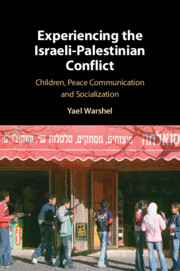Book contents
- Experiencing the Israeli-Palestinian Conflict
- Experiencing the Israeli-Palestinian Conflict
- Copyright page
- Dedication
- Contents
- Figures
- Tables
- Acknowledgments
- Note on the Text
- Abbreviations
- Introduction
- Part I The Encoding and Production of Israeli and Palestinian Sesame Street
- Part II Audience Reception of Israeli and Palestinian Sesame Street
- Introduction to Part II: Audience Reception Methodologies
- 4 Decodings by Palestinians-in-the-Making
- 5 Decodings by Jewish Israelis-in-the-Making
- 6 Decodings by Arab/Palestinian Israelis-in-the-Making
- Conclusion to Part II: The Utility of the Series for All Three Partners to the Conflict?
- Part III Situating the Reception of Israeli and Palestinian Sesame Street in Mundane, Intractable Conflict Zone Practices
- Part IV Conclusions and Recommendations to Improve Peace Communication Research, (Evidence-Based) Practice and Conflict Intractability Interpretation
- Book part
- References
- Index
- Plate Section (PDF Only)
6 - Decodings by Arab/Palestinian Israelis-in-the-Making
from Part II - Audience Reception of Israeli and Palestinian Sesame Street
Published online by Cambridge University Press: 08 July 2021
- Experiencing the Israeli-Palestinian Conflict
- Experiencing the Israeli-Palestinian Conflict
- Copyright page
- Dedication
- Contents
- Figures
- Tables
- Acknowledgments
- Note on the Text
- Abbreviations
- Introduction
- Part I The Encoding and Production of Israeli and Palestinian Sesame Street
- Part II Audience Reception of Israeli and Palestinian Sesame Street
- Introduction to Part II: Audience Reception Methodologies
- 4 Decodings by Palestinians-in-the-Making
- 5 Decodings by Jewish Israelis-in-the-Making
- 6 Decodings by Arab/Palestinian Israelis-in-the-Making
- Conclusion to Part II: The Utility of the Series for All Three Partners to the Conflict?
- Part III Situating the Reception of Israeli and Palestinian Sesame Street in Mundane, Intractable Conflict Zone Practices
- Part IV Conclusions and Recommendations to Improve Peace Communication Research, (Evidence-Based) Practice and Conflict Intractability Interpretation
- Book part
- References
- Index
- Plate Section (PDF Only)
Summary
This chapter looks at the interpretations of the series by the Arab/Palestinian Israeli state minority audience in Uhm Al-Fahm. Half decoded “Jews”; one-third decoded Palestinians. All concluded there were “Arab” characters in Sesame Street, meaning Arab/Palestinian Israelis. Drawing on assumptions about language, physical features, or attire of characters, they typically converted Jewish Israeli characters into “Arabs,” moving them from the national to the civic axis, still Israeli but specifically Arab/Palestinian Israelis like themselves. Palestinian characters moved from the civic to the national on the continuum, and were interpreted as just “Arabs.” A majority held negative to very negative attitudes about Jewish Israelis, and very positive to very negative attitudes about Palestinians, their other shared other. In some cases they negatively stereotyped the former as “police” and the latter as “dirty, primitive or poor.” Optimistically for peace-building, most nonetheless adopted positive attitudes toward all the characters they had “correctly” decoded as pro-social and nice, and were able to generalize those mediated experiences to the other characters on screen and to the real world. This suggests there is some room for Sesame Street to influence the Arab/Palestinian Israeli audience’s inter-grouping attitudes towards these shared others.
Keywords
- Type
- Chapter
- Information
- Experiencing the Israeli-Palestinian ConflictChildren, Peace Communication and Socialization, pp. 199 - 208Publisher: Cambridge University PressPrint publication year: 2021



